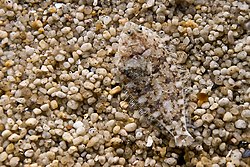Pleuronectoidei
| Flatfish Temporal range: Paleocene–Recent |
|
|---|---|
 |
|
| A camouflaged flatfish. | |
| Scientific classification | |
| Kingdom: | Animalia |
| Phylum: | Chordata |
| Class: | Actinopterygii |
| Superorder: | Acanthopterygii |
| Order: | Pleuronectiformes |
| Families | |
|
Suborder Psettodoidei
Suborder Pleuronectoidei
Suborder Soleoidei
|
|
| This article is one of a series on |
| Commercial fish |
|---|
| Large pelagic |
|
billfish, bonito mackerel, salmon shark, tuna |
|
|
| Forage |
|
anchovy, herring menhaden, sardine shad, sprat |
|
|
| Demersal |
|
cod, eel, flatfish pollock, ray |
| Mixed |
| carp, tilapia |
Suborder Psettodoidei
Suborder Pleuronectoidei
Suborder Soleoidei
A flatfish is a member of the order Pleuronectiformes of ray-finned demersal fishes, also called the Heterosomata, sometimes classified as a suborder of Perciformes. In many species, both eyes lie on one side of the head, one or the other migrating through or around the head during development. Some species face their left sides upward, some face their right sides upward, and others face either side upward.
Many important food fish are in this order, including the flounders, soles, turbot, plaice, and halibut. Some flatfish can actively camouflage themselves on the ocean floor.
Over 700 species are in the 11 families. The largest families are Bothidae, Cynoglossidae, Paralichthyidae, Pleuronectidae, and Soleidae, with more than 100 species each (the remaining families have less than 50 species each). Some families are the results of relatively recent splits. For example, the Achiridae were classified as a subfamily of Soleidae in the past, and the Samaridae were considered a subfamily of the Pleuronectidae. The Pleuronectidae may be split further still, as some authorities elevate Paralichthodinae, Poecilopsettinae, and Rhombosoleinae to families instead of subfamilies.
The taxonomy of some groups is in need of a review, as the last monograph covering the entire order was John Roxborough Norman's Monograph of the Flatfishes published in 1934. New species are described with some regularity and undescribed species likely remain.
...
Wikipedia
